NORTH WALES COAST RAILWAY :NOTICE BOARD
Rheilffordd arfordir gogledd Cymru: Hysbysfwrdd
14 August 2023




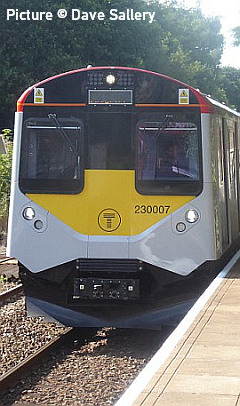
Contributions to the Notice Board are welcome, although they may not always be used, due to time constraints, especially if they don't follow the file name convention given on the Contributions Page.
Forthcoming events
Charter trains, and meetings, may be subject to cancellation or postponement. See our Calendar Page for Club and Society details.
September 2023
Friday 1 September
Clwyd Railway Circle
A Year in the Life of an International Train Spotter - Part 2. Phil Thomas
Wednesday 13 September Statesman Rail The Snowdonia Statesman High Wycombe IST Birmingham NS - Betws-y-coed/Blaenau Ffestiniog LSL Pullman
16-17 September : Bala Model Show Ysgol Godre'r Berwyn School, Ffrydan Road, Bala, Gwynedd LL23 7RU
10.00-16.00 both days
Approximately 20 layouts, half standard gauge, half narrow (including live steam).
October 2023
Friday 6 October Clwyd Railway Circle A History of The Internal Railway at Shotton Steelworks and its Links with the Main Line. Glyn Jones
11 October Statesman Rail The Snowdonia Statesman Stevenage - Nuneaton - Betws-y-coed /Blaenau Ffestiniog LSL Pullman
November 2023
Friday 3 November Clwyd Railway Circle The Railway in Conway. Larry Davies
December 2023
Friday 1 December Clwyd Railway Circle Members Night Presentations. Members are invited to give a 15-minute presentation of their choice.
(see our Calendar page for meeting venues)
North Wales Coast Railway website created and compiled by Charlie Hulme
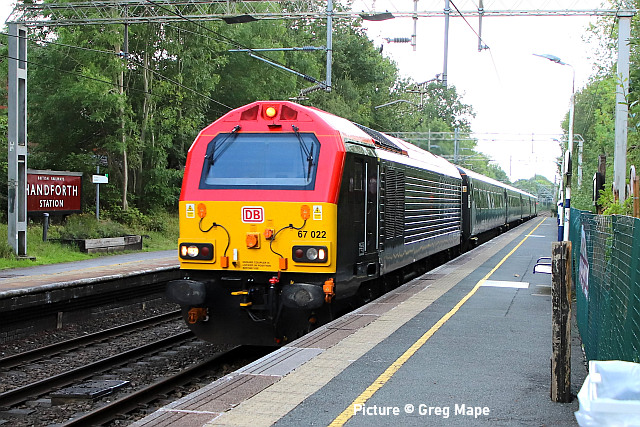
The 14:53 Cardiff - Manchester service on 12 August speeds through Handforth with 67 022 leading. Picture by Greg Mape.
Another Round Robin - report by Gary Thomas
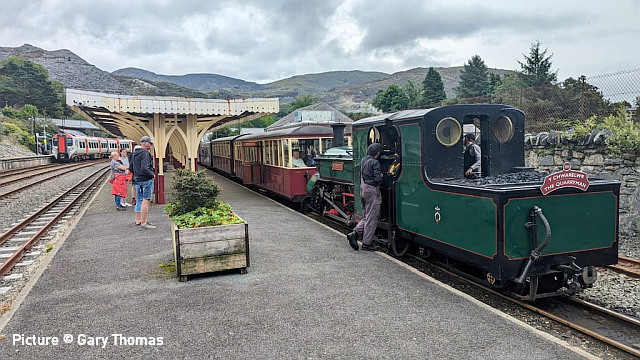
I did my second Ffestiniog Round Robin trip of the year on 8 August, this time anti-clockwise for the first time, starting and ending in Llandudno Junction. Above: Former Penrhyn Quarry Railway locomotive Blanche and 197 016 in Blaenau Ffestiniog. The latter had brought us up the branch, though only gave us two rather than the hoped-for six minutes to cross the tracks.
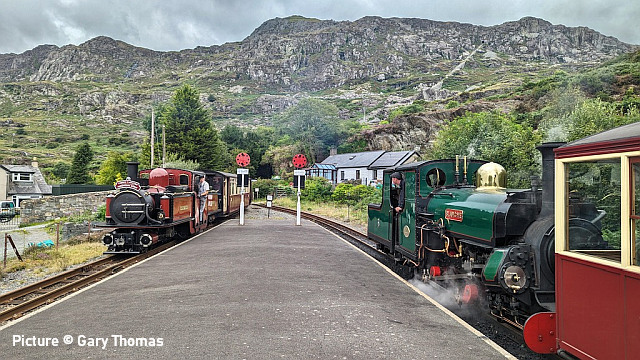
Blanche and Double Fairlie, David Lloyd George crossing at Tanygrisiau. We passed three services on our way to Porthmadog, all very well loaded. However, all were running late, resulting in our arrival in Porthmadog 25 minutes late.
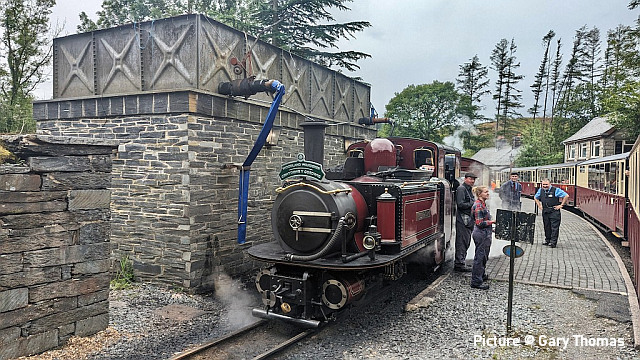
Double Fairlie Merddin Emrys takes on water at Tan-Y-Bwlch having just arrived from Porthmadog.
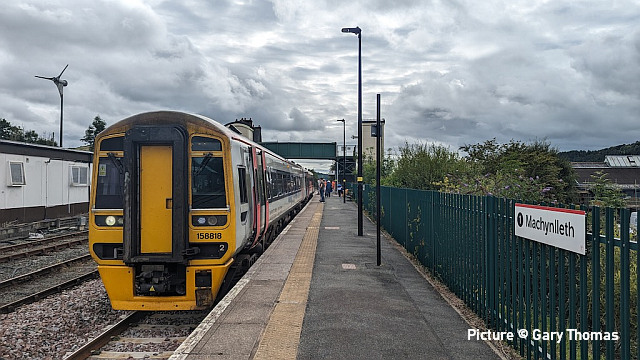
158 818 waits patiently at Machynlleth for another 158 from Aberystwyth to join it for the run to Shrewsbury.
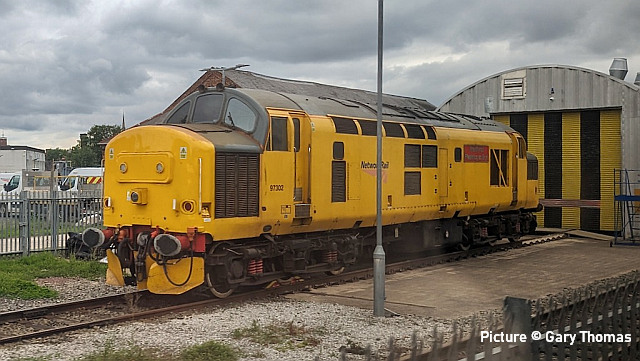
97 302 rests at an otherwise quite Coleham Depot, Shrewsbury.
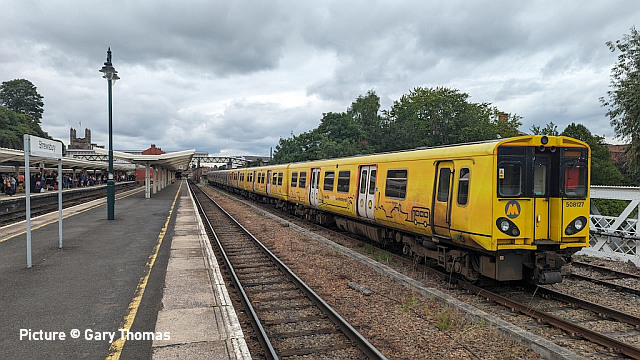
Ex-Merseyrail EMU 508 127 (with 507 005 at the rear) at Shrewsbury. The EMUs had been on their way from Birkenhead to Sims at Newport for scrapping...
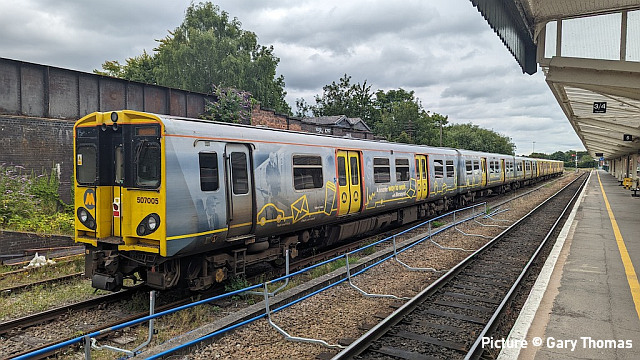
... but had been detached from the locomotive hauling them, resulting in their unplanned stay at Shrewsbury for a few days. 507 005 at the other end.
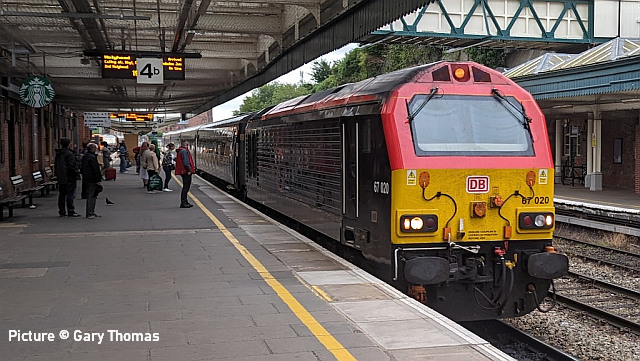
67 020 arrives on-time (!) at Shrewsbury with the evening Cardiff Central to Holyhead "WAG" service. We could have got two earlier services, but wanted an early dinner and some loco haulage!
With the exception of a few minutes lost on the first train up to Blaenau and on the Ffestiniog itself time keeping was excellent, with all trains well presented.
As ever purchasing the ticket provided a challenge, with the ticket office clerk in Llandudno Junction denying the existence of the ticket despite me having exactly the same conversation with the same person two months prior! Showing them the relevant details from the excellent Railrover.org and BRfares.com websites solved their amnesia.
The ticket has gone up a little from last year but still represents outstanding value at £27.90 with railcard (and £43.30 without railcard). It costs almost the same for a one-way ticket on the Ffestiniog! But remember that on the Round Robin you have to book a place for the Ffestiniog section by phoning their booking office, 01766 516000. For full(-ish) details go to the TfW website, which illustrates the page with a view of South Stack lighthouse at Holyhead, whose station is not included in the itinerary.
In other news, 3-car 197 110 arrived empty from Chester on the morning of Sunday, 13 August and worked the Blaenau branch all day. This must be the first 3-car DMU on the line since 'Daisy' ran on the line 20 years ago. I don't know whether this was planned or not; TfW's scheduling is a mystery to me, as veteran 150/2 Sprinters still regularly make the trip from Holyhead to Cardiff!
News Pictures
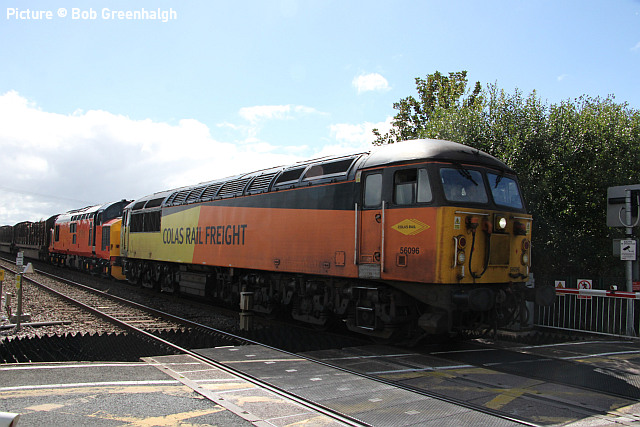
Bob Greenhalgh writes: 'The Aberystwyth to Chirk logs was a bit of a saga this week. Friday saw it run as far as Shrewsbury. Saturday afternoon it ran from Shrewsbury to Chester to run round and then back to Chirk. I photographed it at Green Lane crossing, Saltney (above) and was amazed to see 56 091 with 37 405 which usually comes off at Shrewsbury, tucked in behind. Hoping the 37 would lead on its run to Chirk I was sad to see the 56 leading and the 37 on the back. Such is life!'
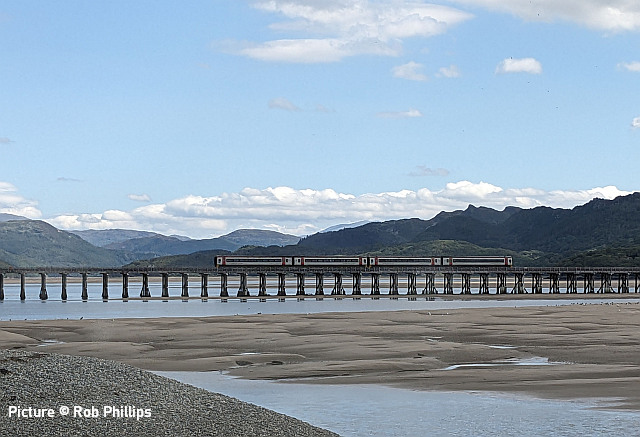
From Rob Phillips: ' On my way back from the Eisteddfod on 10 August I called into the Fairbourne Railway for a ride and was fortunate to seethe late running 2J07 (10:55 Machynlleth - Pwlheli) formed of 158 818 + 158834 leaving Morfa Mawddach and crossing Barmouth bridge - the attached pictures are taken from the Barmouth Ferry station. It was the first time I've seen a 4 car 158 on the Cambrian and I'm sure the extra seats were much appreciated by the passengers.
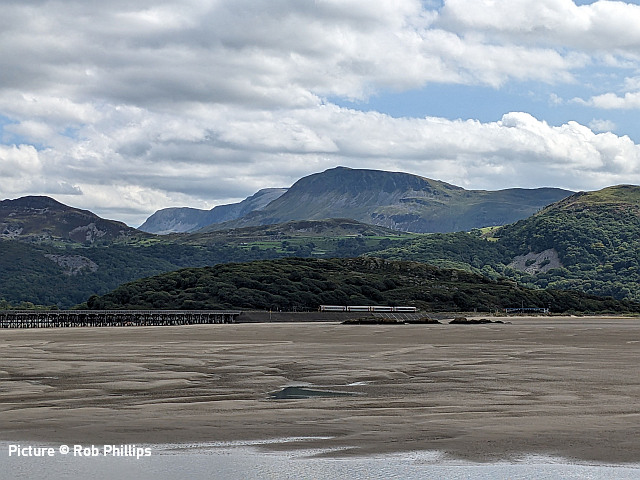
The pair of 158s travelled all the way from Birmingham International; Passengers for Aberystwyth transferred to a train that started at Machynlleth in the shape of 158 820.
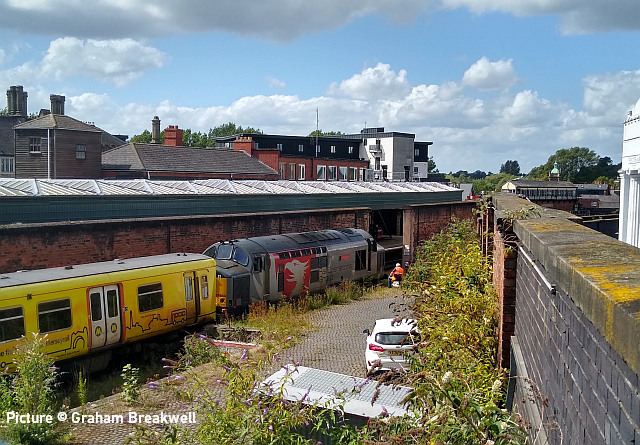
From Graham Breakwell: 37 884 Cepheus arrived at Shrewsbury on Thursday 10 August as 0D64, the 17:50 light-engine from Newport Docks (Simsgroup), stayed overnight and then took 507 005 and 507 127 as 5Q42, the 15:09 onwards to Crewe South Yard. Above, a view from the Dana bridge of the train standing at the Crewe end of the Down main line alongside the disused goods platform waiting the all clear while a crew member takes a break on a chair provided. Crewe Junction signal box is in the background and the grand facade of The Buttermarket on the right.
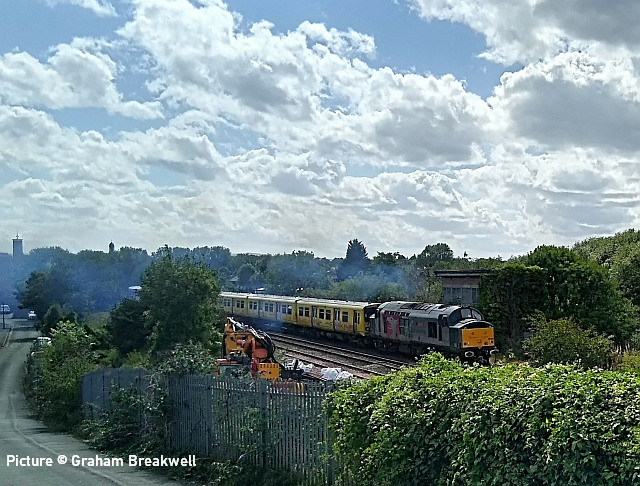
Under impressive cloud formations, 37 884 ascending Crewe bank on the departure from Shrewsbury, leaving its own trail of clouds.
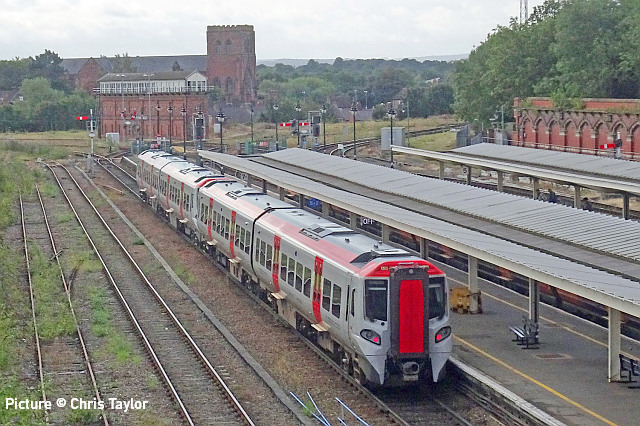
From Chris Taylor: A couple of new CAF DMU's 197 044 and 197 010 departing Shrewsbury on the 06:38 Holyhead to Cardiff Central with Severn Bridge Junction signal box in the background. This box is the largest mechanical signal box in the world today. Taken on 12 August.
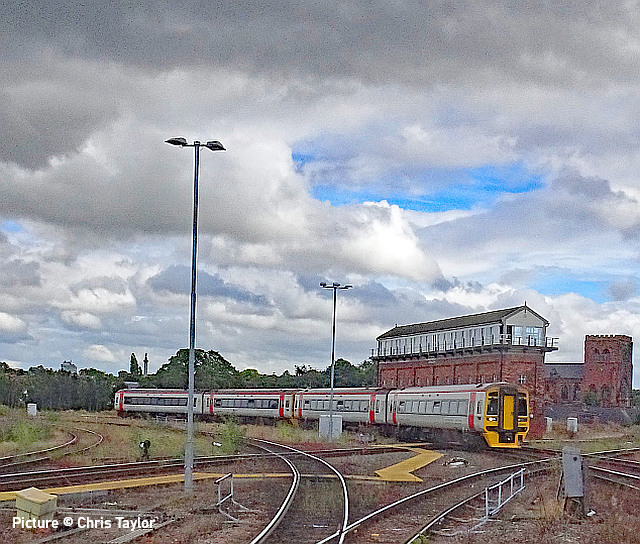
The 15:08 Birmingham International to Holyhead train eases passed Severn Bridge signal box on the same day formed of 158 820 and 158 840. 158 820 was detached at Shrewsbury.
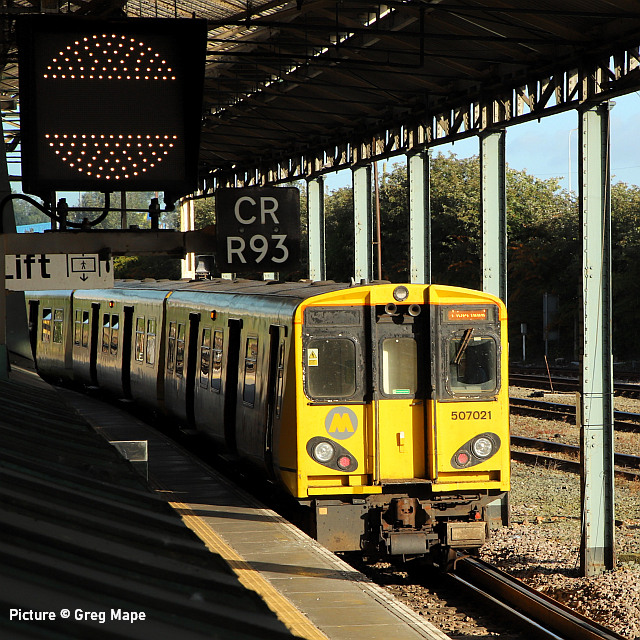
From Greg Mape: In the twilight days of the 507s on 11 August, 507 021 in Platform 7 at Chester.
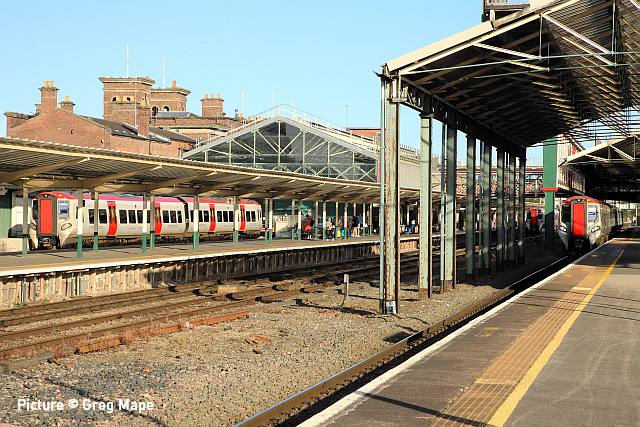
Elsewhere in the station, Class 197s rule.
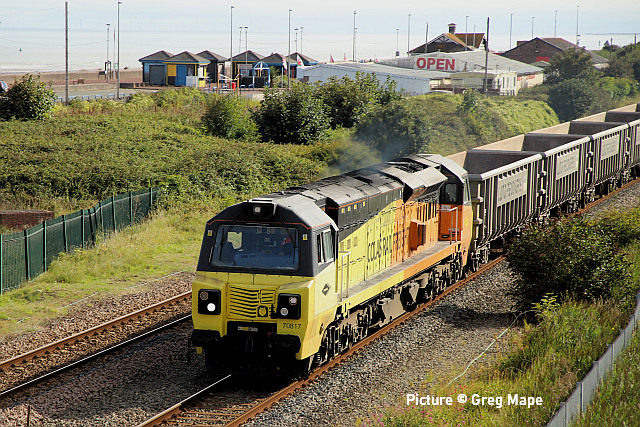
70 817 passing Abergele on 9 August hauling a Longport to Penmaenmawr Quarry empties.
Riding the 230s - report by Dave Sallery
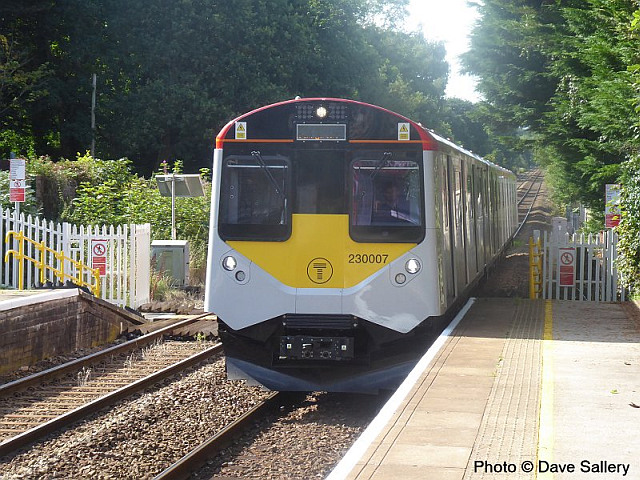
I had a most interesting interesting day on 7 August. I went out with a friend to 'do' a 230 on the Wrexham - Bidston line. We started at Hawarden and bought a return from Shotton to Bidston, as the line is free in Wales on your bus pass. The Train was 20-odd late, not uncommon, with unit 230 007 (seen above at Hawarden). At Bidston the plan was then to go to Wrexham. The Guard said 'we're going to run non stop to Wrexham to make up time'. Exciting times as although I've been using the line since the 60's I've never missed a booked stop, never mind all of them! The non-stop trip with 230 007 from Bidston to Wrexham General took just over 44 minutes.
We got to Wrexham without making up any time and the Guard said if you want to go back to Hawarden then over the bridge. So we were then on 230 009, which we then did back to Bidston. At Bidston we did a Merseyrail 'bash' over to Lime Street. We had a mooch about there, then then back to Bidston where 230 009 took us back to Hawarden, still about 20 minutes late.
A strange way to run a railway! Despite all that I still think the 230 is a nice train for passengers.
Strike up the Band ... at the Talyllyn - by Mark Hambly
For those who like brass band music with their steam trains then Abergynolwyn station on the Talyllyn Railway is the place to be at noon on Tuesday 22 August when the National Methodist Youth Brass Band will be giving a free concert as part of their Cymru 23 summer tour. Abergynolwyn is their only railway station venue although they can also be heard at Aberystwyth Bandstand, Portmeirion, Caernarfon Castle, Bangor Pier and Penmaenmawr Promenade during week commencing Monday 21 August, with the full programme available on the Band's Facebook page The National Methodist Youth Brass Band | Facebook
I must declare an interest, in that both my daughters play in the band (although only one will be on this summer's tour). I also happen to know that this year's tour organiser is a transport professional and dedicated railway enthusiast!
From Dave Sallery's archive
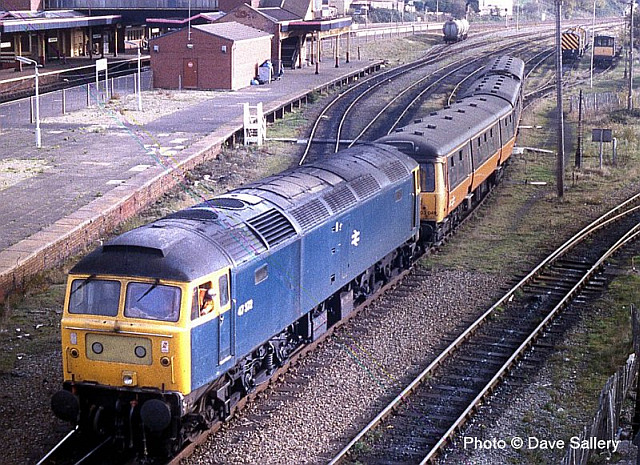
One-time Glasgow 'Blue train' 303 049 is seen being shunted by 47 372 in Llandudno Junction yard on November 5th 1991. The unit had been in store there for a couple of years since being declared surplus from the Manchester area. It was on its way to Clacton where it was converted into a test train for Network South East. 303 049 was renumbered to 303 999 and used by Network South East until 1996 after which it was scrapped.
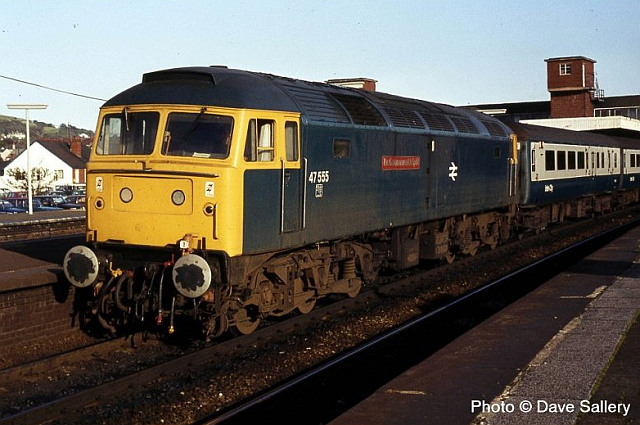
Coast regular 47 555 The Commonwealth Spirit at Llandudno Junction, 24 October 1983. The former D1717 and 47 126 was cut up at Wigan in April 2000.
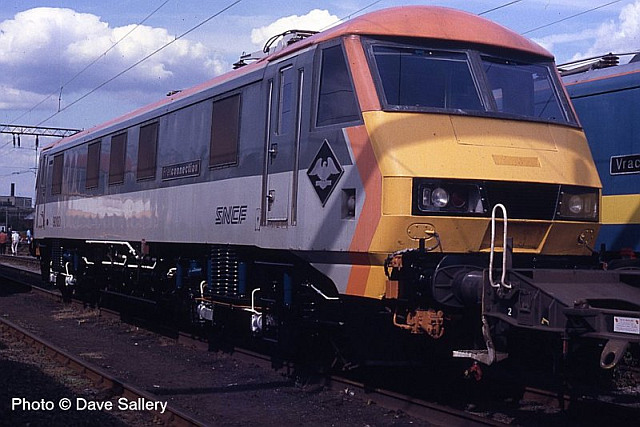
90 130 Fretconnection at Crewe Basford Hall yard on 21 August 1994. This loco is in SNCF livery, there were also German and Belgian variations. Repainted in anticipation of the opening of the Channel Tunnel and the huge improvement that was going to make to freight on rail. I wonder what happened to those brave predictions?
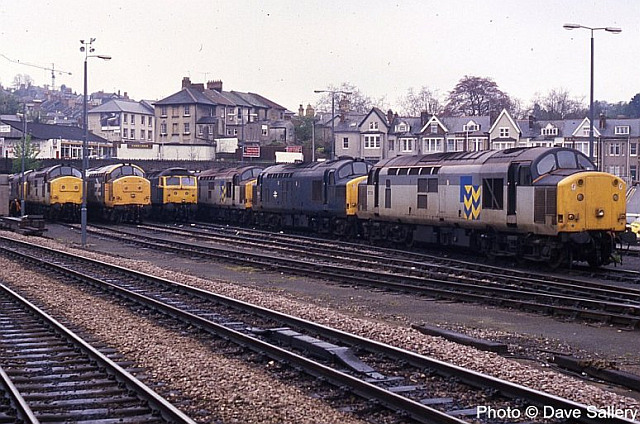
A typical line up at Newport Godfrey Road stabling point on 29 April 1989. The area is now a car park and no trace remains.
Pathfinder Pembroke Coast Express - report by Richard Putley
On Sunday 6 August a friend and I had decided to ride the above train and take the Premier Dining option. Due to its early departure time, 08:55 from Bradford on Avon, I opted to drive to there. We arrived in plenty of time to see several other trains:
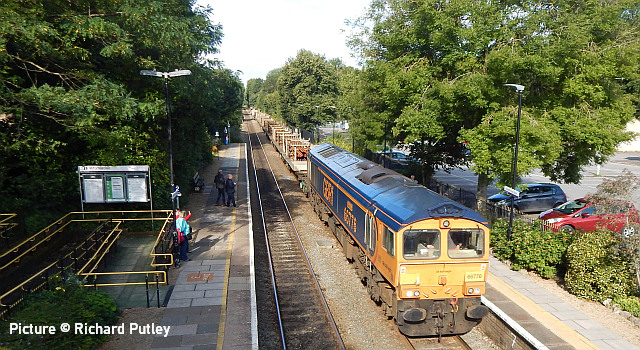
GBRf 66 776 and 66 723 top and tailing a train of welded rails (above) and 166 202 – still in First Great Western Blue on the 08:52 to Bristol Temple Meads.
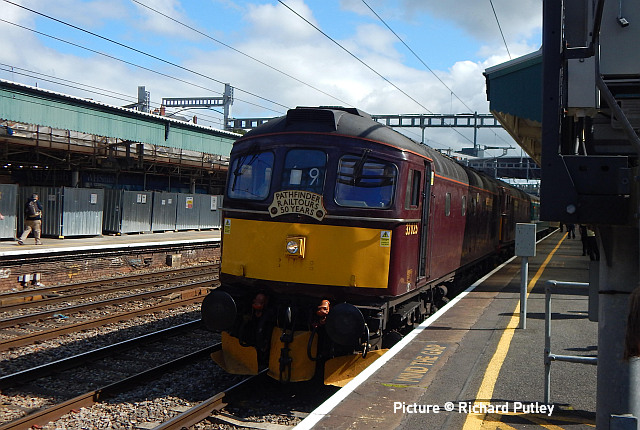
Our tour arrived punctually with 33 025 and 33 029 at the head, both in West Coast Railways maroon. A punctual run ensued to Newport, where we had a 15 minute break which enabled me to photograph the tour. The driver also decided to set the headcode to 89. I gather this was the old Southern Regoin headcode for Portsmouth – Cardiff trains!
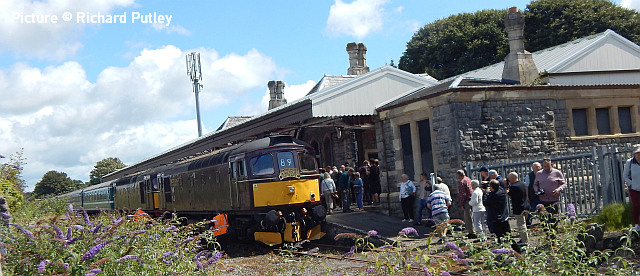
We continued via the South Wales Mainline to Whitland where we had to wait for a service train from Pembroke Dock to come off the single track branch, This caused a delay of ten minutes and so arrival at Pembroke Dock was 10 minutes late. We were only booked to stay there for 20 minutes and our departure was also 10 minutes behind.
As there is no run round there , 47 813 had been coupled on the rear of the train and it burst into life.
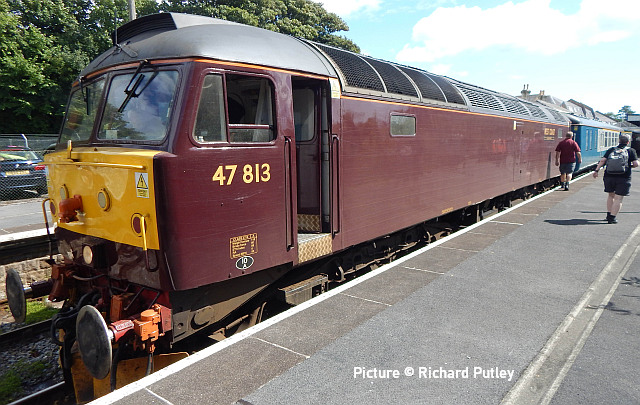
We were booked for a 90 minute break at Tenby where I photographed 47 813 but a late arrival there cut it down to just over an hour. Still this was enough to find a suitable hostelry for a drink.
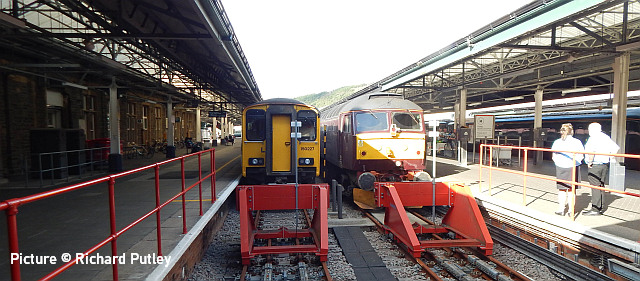
Departure from Tenby was on time but we then stuck behind a late running train on the mainline. The tour went into Swansea station and then the 33s lead for the rest of the way. Deparute was 15 minutes late and we arrived back at Bradford on Avon about a quarter of an hour late. Nevertheless a very enjoyable day out, helped by good weather.
Looking back: Crane tanks - with David Pool
Industrial steam locomotives never had the same attraction as their British Railways counterparts, so there will have been relatively little attention paid to the family of steam crane locomotives, or crane tanks as they are often called. In general they would have a lifting capacity or around five tons, and have a jib which would slew to reach as far as the adjacent track. Even with these limitations, they were usefully employed in ironworks and dockyards in the first half of the 20th century. Fortunately several have been preserved, some able to be steamed to demonstrate their capabilities.
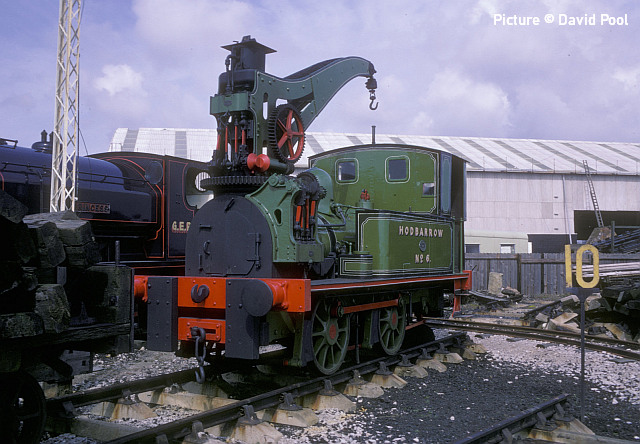
One of the oldest crane tanks in preservation is Neilson 4004 (1890), which I photographed on 16 April 1972 at the Lytham Steam Museum. The separate steam driven mechanisms for rotating the jib and winding the hoist are clearly shown. It had been used at the Hodbarrow mines near Millom, in Cumbria. I found a rather deserted site, but with the exhibits well displayed and restored. Apparently this privately owned Museum was not regularly open, and did not attract much publicity. Eventually it closed – I have not found any confirmed date - and many of the items were sold to new owners. It has been reported that this crane tank may still be at Lytham, but not on public display.
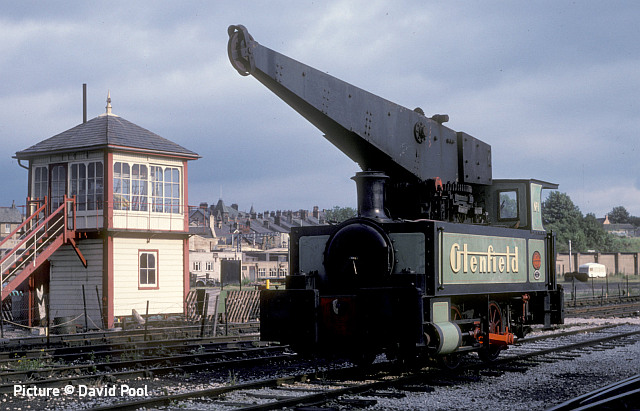
Andrew Barclay was another supplier of crane tanks, and AB 880 (1902) Glenfield had gone to Glenfield and Kennedy’s Foundry nearby at Kilmarnock, where it was still working in 1966. After it had been withdrawn, it moved to Didcot, where the Oxford Polytechnic Transport Society arranged for some restoration to enable it to be steamed, although its movements were very restricted. It later moved to Rutland, and then to Carnforth, where I saw it on 1 July 1980.
Glenfield then had a number of owners, going to Statfold Barn and then to Chasewater and the Ribble Steam Railway for storage, but by 2023 it was back at Statfold Barn and on display outside the main entrance.
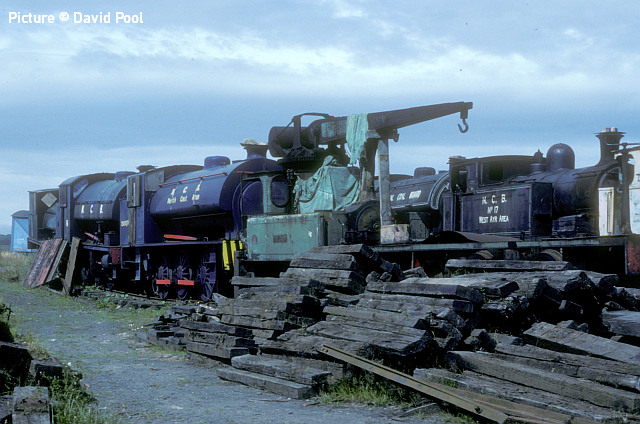
Possibly the most famous site for crane tanks was at Pallion, near Sunderland, where Doxford Shipbuilders had nine locomotives, four of which are now in preservation. They had been built by Robert Stephenson and Hawthorn, the last being delivered in 1942. All were withdrawn by 1971. RSH 7069 (1942) Southwick at Dinting and sister locomotive 7070 (1942) Millfield at Bressingham were illustrated in the Notice Board of 23 February 2023. RSH 7007 (1940) Hendon was first photographed at the Tanfield Railway on 28 July 1983, sandwiched between rows of NCB steam locomotives.
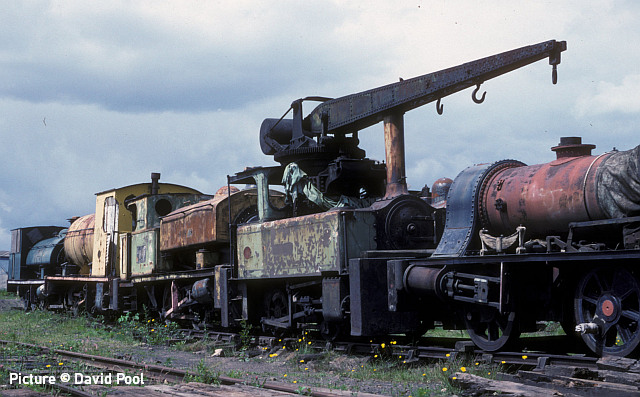
On a return visit to Tanfield on 28 June 1990 Hendon was now more clearly visible. A peculiarity of these crane tanks was that the hoisting movement was achieved by raising the jib, the hook being fixed at the end of the jib, so there was no need for a hoist rope and a winding drum.
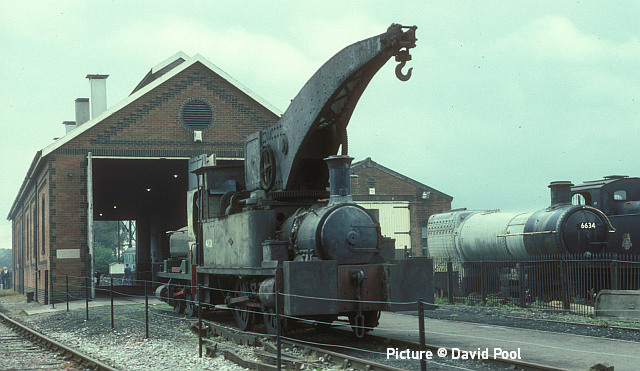
Another builder of crane tanks was Dübs of Polmadie, Glasgow. In 1903 it merged with other companies to form the North British Locomotive Company, but shortly before the merger it built a crane tank, 4101 (1901) for the Shelton Iron and Steel works, Stoke on Trent. Towards the end of its working life there 4101 was converted to oil burning, and operated until 1968. It was then purchased for preservation, eventually arriving at the East Somerset Railway at Cranmore in 1973, where it worked as a shed pilot and on track construction. It was converted back to coal firing in 1977, and continued in use until 1986, at which time the boiler needed major repairs. I visited Cranmore on 3 October 1993, when “Dubsy” was looking for a benefactor.
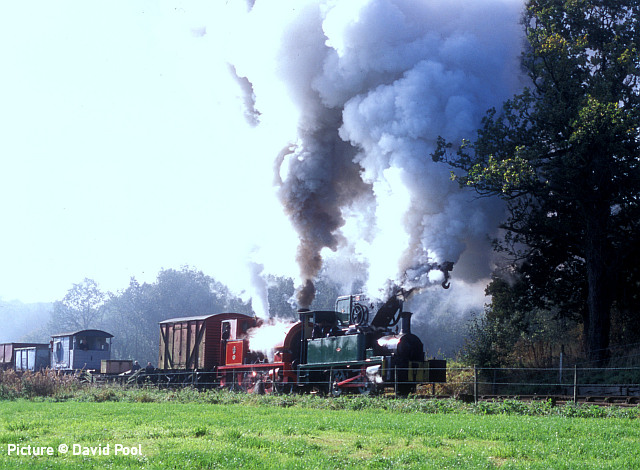
In 1999 4101 was bought by the Foxfield Railway, and eventually was restored to steam in 2010. The Steam Gala on 15 October 2011 gave me the opportunity to see 4101 at work, although primarily as an assisting locomotive for the fearsome 1 in 19 gradient out of Dilhorne. The other locomotive on the first train was Bagnall 2842 (1946).
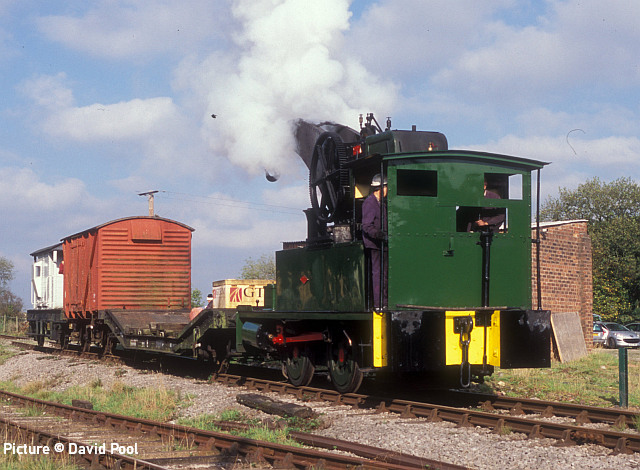
There had been a suggestion that 4101 would be demonstrating the use of its crane during the day, but it was just shunting a few wagons in the sidings at Dilhorne when I returned.
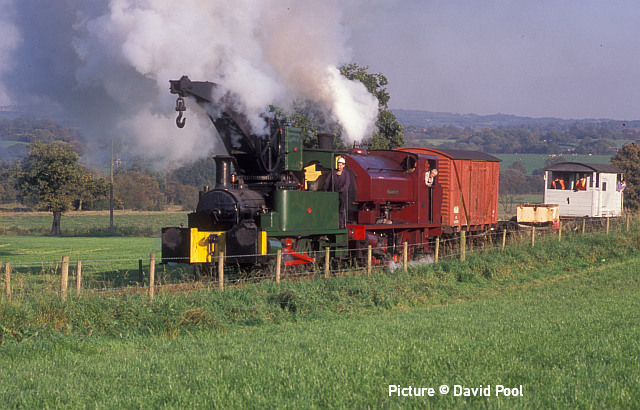
The afternoon train with 4101 had it paired with Florence No.2, another Bagnall, 3059 (1954). The pair put on a good display for the spectators further up the bank, where the gradient was easing to a mere 1 in 26!
North Wales Coast home page | Archive | Previous Notice Board